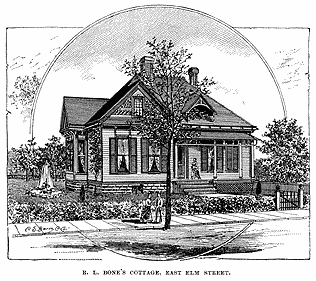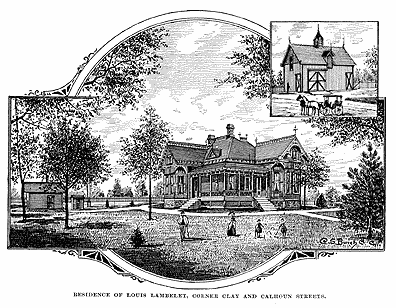SPRINGFIELD, MISSOURI AND SURROUNDINGS • 1889
(previous
page) Total wholesale and retail yearly trade $10,436,200
Total wholesale and retail stocks carried..... 3,874,900
Total number of men employed.....1362
In his Board of Trade Report for 1888, Mr. J. R. Ferguson puts the Real Estate Transfers of the city at $3,750,700, and the estimated annual out-put of all the shops, mills and factories easily reaches $2,500,000. If these magnificent figures be added, the total of yearly business as above given, will be swelled to the startling sum of $16,686,900. And by adding to the aggregate value of capital invested in trade, as above given, $3,000,000 for the cost of the railway shops, factory, mill, gas, electric light, ice, water works and other plants of the city, and the actual capital employed in operating them, the total amount invented in commercial and industrial enterprises will aggregate $6,874,900.
From the figures already given, the total number of hands employed in these commercial and industrial enterprises is fully 3862, and if to these be added at least 3000 more wage-workers, embracing all the mechanics outside of the mills, factories and larger shops, the brickmakers, clerical workers in banks, hotels and offices, printers, teamsters, men on the public works, hotel employees, seamstresses and the big list of common laborers and domestics, we have here AN ARMY OF WAGE WORKERS, male and female, numbering 6862 whose daily hire is not less than $8000, equal to $208,000 per month or $2,496,000 a year, a princely sum, that goes into current circulation, giving wonderful impulse to trade, banking, house building and every vital interest of the city. The GROWTH OF TRADE AND INDUSTRY has fully kept pace with the increase in population, having more than doubled within the past six years, and it is asserted on good authority, that 85 per cent. of the mercantile and general business capital has been MADE ON THE SPOT, by the sure ways of local trade and industry. Many of the ablest merchants, manufacturers and capitalists began business here on a small scale with little means, and the bulk of their wealth is the creation of the present decade, during which there has been no abatement in material growth. The BUILDING OPERATIONS of the present year, which as heretofore noted, involve the construction of not less than 600 homes, business houses, shops and other structures (including the large car shops of the Gulf Railroad) at a cost of $800,000, are but a repetition of the splendid work of the six preceding years. In all the nine square miles now included in the corporate limits, or at least within the range of the newly platted additions, there are few blocks of hitherto unoccupied ground upon which a pretty or elegant home is not under construction. The fine BUILDING AND LOAN ASSOCIATIONS representing an available capital of about $450,000, have been ministries to the material prosperity of the city, which can hardly be overestimated, for they have made possible the building of hundreds of comfortable homes by men who would otherwise have remained homeless. The BANKING INTERESTS of the city are in capital condition, and evidently in very capable hands. The eight banks have a combined capital of $750,000, surplus funds aggregating $135,000, and carry average deposits of $1,300,000. A large increase in the capital of these institutions during the last year has greatly facilitated business and there is no want of ready money for all legitimate enterprises.
The Central National Bank, organized June 1887, has a cash capital of $200,000, and a surplus fund of $10,000, and ranks with the strongest and most popular banking concerns in the Southwest. It has steadily grown in local popularity and patronage from the date of its opening, and is honored with the chief correspondence of the country banks in Southwest Missouri and Northwest Arkansas. Its new building, offices and fixtures cost $25,000, and are models of fine style and finish. Col. J. W. Powers, the president and organizer of the Central National, has been continuously in the banking business for twenty years. He was the founder and manager of the pioneer banks at Salina and Ellsworth, Kansas, the first west of Junction City, and has made an enviable record in the one work of banking, for which his rare executive and financial gifts eminently fit him. He is interested in the National Bank of Commerce, Kansas City, and in banks at Mountain Grove, Mo. and Newport, Ark., and with his ample fortune and generous public spirit, is a capital acquisition to the social and business city. Mr. J. D. Sheppard, the cashier, was trained to banking from a boy, in this city, and is an accomplished financier and clerical worker, to whom the whole work of banking is as familiar as an open book. The Central National has a north side office, on Commercial Street, under the management of Mr. E. P. Newman; is sound as the Bank of England, and is daily growing in popular favor.
The Greene County Bank was organized in Feb., 1888, to succeed the Greene County National Bank, which was chartered in 1867, and ranks with the foremost banking houses in Southwest Missouri. It has a capital of $100,000, a surplus fund of nearly $8,000, and a strong list of officers and directors, embracing some of the ablest and oldest business men of the community. Capt. Geo. M. Jones, the newly elected president, is one of the solid, conservative, successful capitalists and financiers of the city, whose tastes, capabilities and fortune, particularly fit him for bank management. Mr. G. D. Milligan, the vice-president, is a leading merchant and capitalist, and Mr. E. H. Grabill, the cashier, a capable and conservative financier of ample means and banking experience. The bank is strongly fortified in (next page)
Page
1 | 2 | 3 | 4 | 5 | 6 | 7 | 8 | 9 | 10 | 11 | 12 | 13 | 14 | 15 | 16 | 17 |
18 | 19 | 20 | 21 | 22 | 24 | 25 | 26 | 27 | 28 | 29 | 30 | 31 | 32 | 33 | 34 | 35
Springfield 1889 Home | Keyword Search | Engravings Thumbnails | Local History Home


